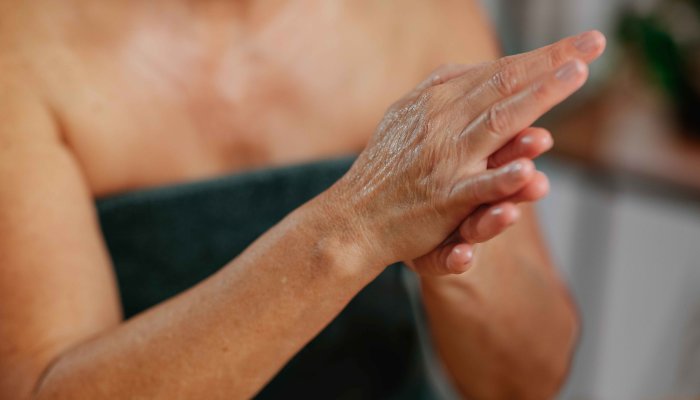

Skin changes with age: That’s an inevitable part of life. From collagen and elastin decline to structural changes in the skin barrier, aging is inevitable. And how the skin looks due to those changes is different for everyone. Some folks experience more sagging, while others form deep wrinkles—some develop dark spots, while others deal with crepey skin.
While these changes are natural and normal, you can be proactive with your skin care routine to support the skin through new phases of your life. By knowing why a change is occurring, we can better know how to treat the skin accordingly. Understanding your skin is still the best skin care treatment.
In the case of crepey skin, there are several factors that may be influencing the skin’s appearance. “Skin ‘crepiness’ is commonly used to describe aging skin that has lost elasticity, appearing thinner and more fragile, often with wrinkles,” explains board-certified dermatologist, dermatologic surgeon, and founder of Spectrum Skin and Laser Jeremy Brauer, M.D.
Here, why the skin thins—and what to do about it.
Unprotected UV exposure damages skin cell DNA, breaks down collagen and elastin, and triggers dark spot formulation. In fact, sun damage can account for up to 80% of all visible signs of aging.
It’s also the primary cause of crepey skin. As board-certified cosmetic dermatologist Divya Shokeen, M.D., FAAD, tells us, it’s most often triggered by excessive sun exposure, especially if crepey skin starts to show up in your 20s or 30s. Shokeen notes crepey skin starting in your mid-20s is more often caused by notable tanning bed use or aggressive, unprotected sun exposure (i.e., regular sunbathing without SPF).
“Over time, aggressive or excessive exposure to the sun breaks down elastin in your skin. Elastin usually has the ability to stretch and recoil, but with repeated sun damage it loses the ability to heal properly and so remains stretched. This laxity leads to the appearance of lax or crepey skin,” Shokeen explains.
This fix is easy: Wear sunscreen and utilize protective accessories (i.e. UFP clothing, hats, and sunglasses), especially when outdoors during peak sunshine hours. For help finding a sunscreen that suits your needs, check out our all time favorite natural sunscreens.
Crepey skin is often exacerbated by transepidermal water loss in the skin.
“Moisture retention or hydration is a very important component of healthy skin—loss of hydration can result in increased crepiness,” Brauer told mbg. “An intact skin barrier not only protects your body by preventing outside agents (i.e., bacteria) from getting in but also by preventing water from getting out, maintaining hydration and locking in moisture. When your skin barrier is compromised, there is a greater loss of water, resulting in decreased skin turgor, which ultimately leads to crepey skin.”
To improve skin barrier function, it’s important to use strengthening ingredients such as fatty acids, antioxidants, humectants, and biotic actives (such as pre and postbiotics). mindbodygreen’s postbiotic body lotion uses a deeply hydrating combo of shea butter, coconut oil, aloe vera, oat oil, coenzyme Q10, pre- and postbiotics, and more.
CoQ10, for example, is a fat-soluble compound that’s actually found in all your cells (including skin cells). Like other antioxidants, it neutralizes free radicals—but it also protects against lipid peroxidation, a process by which free radicals damage skin cell membranes. Research shows that applying CoQ10 helps boost the skin’s free-radical-fighting abilities and has been found to significantly decrease facial wrinkles.
The skin is made up of proteins, such as collagen, elastin, and keratin. To help your skin regenerate these structural proteins, we need amino acids. And we get those amino acids from our diet. “You need to give your body the raw materials to regenerate,” says board-certified holistic nutritionist Jennifer Hanway.
Board-certified dermatologist Carl Thornfeldt, M.D., aggreesL “Lacking leafy green vegetables and collagen-rich foods can accelerate the development of crepey skin. “Years of ingesting insufficient or poor-quality protein is also a major contributor.”
Be sure to eat a robust diet high in protein, antioxidants, and healthy fats. Protein needs will vary person-to-person, as well as due to what’s happening in your life. But a good rule of thumb is this: most active women will want to consume 1.2 to 2.0 grams of protein per kilogram of body weight. Most of the experts we regularly work with suggest aiming for a goal of around 100 grams of protein per day. “For most women, 100 to 120 grams is a really good starting point,” Hanway says.








